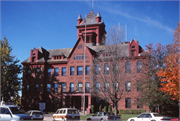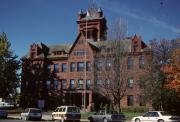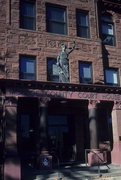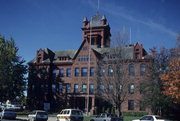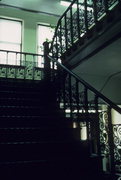Property Record
108 S COURT
Architecture and History Inventory
| Historic Name: | MONROE COUNTY COURTHOUSE |
|---|---|
| Other Name: | MONROE COUNTY COURTHOUSE |
| Contributing: | |
| Reference Number: | 26976 |
| Location (Address): | 108 S COURT |
|---|---|
| County: | Monroe |
| City: | Sparta |
| Township/Village: | |
| Unincorporated Community: | |
| Town: | |
| Range: | |
| Direction: | |
| Section: | |
| Quarter Section: | |
| Quarter/Quarter Section: |
| Year Built: | 1895 |
|---|---|
| Additions: | |
| Survey Date: | 1989 |
| Historic Use: | courthouse |
| Architectural Style: | Romanesque Revival |
| Structural System: | |
| Wall Material: | Stone - Unspecified |
| Architect: | MIFFLIN E. BELL |
| Other Buildings On Site: | |
| Demolished?: | No |
| Demolished Date: |
| National/State Register Listing Name: | Monroe County Courthouse |
|---|---|
| National Register Listing Date: | 3/9/1982 |
| State Register Listing Date: | 1/1/1989 |
| National Register Multiple Property Name: | County Courthouses of Wisconsin Thematic Group |
| Additional Information: | A 'site file' exists for this property. It contains additional information such as correspondence, newspaper clippings, or historical information. It is a public record and may be viewed in person at the State Historical Society, Division of Historic Preservation. COST OF ORIGINAL BUILDING WAS $53,417.79. This building is Monroe County's third courthouse building and was built in 1896. It was placed on the National Register of Historic Places in 1981. This structure meets criteria A of the NRHP. Located in the open historic Court House Square on South Court Street between Oak and Main Street, the Monroe County Court House is a three-story red sandstone building covered by a hipped roof and attic story, exhibiting the symmetrical form and ornamentation associated with the Romanesque Revival style. Classical modillion blocks ornament the cornice under the roof overhang at the top of the elevations. A tall shouldered gable crowns the shallow projecting pavilion in the center of the facade on Court Street and the side elevations. Gabled dormers enclosed by thin piers are set into the south faces of the flared-roof corner pavilions. Hipped-roof shed dormers on the roof alternate with the pavilions. A square tower with open oriels on all faces rises from the deck in the center of the steep hipped roof; round turrets at the corners of the tower penetrate the pyramidal roof. Double hung windows fill the regularly spaced rectangular windows in the coursed rock-faced red sandstone walls; semi-circular transoms mark the location of the courtroom on the east side only of the third story. The entrance is composed of a short flight of concrete steps covered by a denticulated rectangular wood canopy, with square corner columns of wood and round inner columns of polished granite. Decorative cut-stone panels decorate the face of the pavilion overhead; at the attic level, the short open arcade with polished red marble columns is now glazed for protection. The interior of the Court House continues to exhibit the grand staircase in the center pavilion characterized by the original newels, steel treads, and decorative railings. The terrazzo floor and painted plaster walls and ceilings also generally are retained. The Monroe County Court House has been altered by the removal of the statue of Justice from the top of the center pavilion to the deck of the entrance portico. In addition a small one-story brick jail and office building was added in 1965 to the rear of the building [not apparent from the front] to replace an earlier jail built in 1890 with plans from Milwaukee Architect H.C. Koch on the southwest corner of the Court House Square. This addition was enlarged and remodeled in 1988. Constructed in 1896 in place of an earlier court house [the second court house built in Monroe County] in 1865 on the same site historically known as Petit's Square, the present Monroe County Courthouse was designed by the noted architect Mifflen E. Bell (1846-1904). Bell also worked with Alfred Piquenard on the construction of the Illinois Capitol during the 1870s. The Court House was constructed during the year 1895-1896 by M. Yaeger and Son of Danville, Ill., who submitted the lowest bid of $40,593. The iron cornices were manufactured at a shop opened in the Cargill building for that purpose. The Monroe County Courthouse was dedicated in a grand ceremony attended by many county and state officials as well as architect Bell on March 13, 1896. The program opened with a salute by contractor Captain Yaeger's artillary company from Illinois and an orchestra selection by Langstadt's La Crosse, WI orchestra. The Monroe County Courthouse is significant under Criterion C as an exceptionally well-preserved representative of a period of construction. The design, a towered red sandstone building in the Richardsonian Romanesque mode, was the work of Chicago architect Mifflin E. Bell. Clearly the best example of the Romanesque Revival style in the proposed Water Street Historic District and in the City of Sparta as well, the Monroe County Courthouse contributes greatly to the architectural significance of the district. |
|---|---|
| Bibliographic References: | (A) LACROSSE TRIBUNE 9/7/1995. (B) SPARTA MONROE COUNTY DEMOCRAT 3/7/1996; 3/14/1996. (C) TOMAH JOURNAL 3/14/1996. (D) SANBORN INSURANCE MAP, CITY OF SPARTA, 1889, 1894, 1900, 1931. (E) SPARTA HERALD JUNE 3, 1890, JULY 15, 1890; DEC. 18, 1894; JAN. 22, 1895; MARCH 12, 1895; AUGUST 13, 1895; MARCH 17, 1896. (F) NATIONAL REGISTER NOMINATION FORM FOR MONROE COUNTY COURTHOUSE, OCTOBER 1981. Sparta Herald 5/12/1997. Sparta Monroe County Democrat 7/23/1998. |
| Wisconsin Architecture and History Inventory, State Historic Preservation Office, Wisconsin Historical Society, Madison, Wisconsin |

